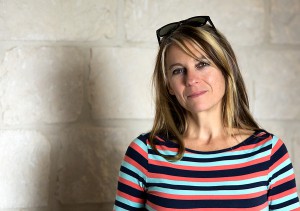SVGE Roundtable: Vision mixers for sports TV production with Blackmagic Design, Grass Valley, NewTek, Ross Video, Snell and Sony
Vision mixers (production switchers) continue to undergo rapid technological developments. But with increasing complexity, can directors still self-vision mix, if necessary? Will IP make any significant differences? Those taking part in our roundtable discussion on these and other issues are (in alphabetical order) Stuart Ashton, director, EMEA at Blackmagic Design; Ellen Camloh, NewTek’s senior product marketing director; John Carter, senior product manager, Snell; Andy Hotten, product marketing manager live production switchers, Sony Europe; Greg Huttie, director, performance switchers strategic marketing, Grass Valley; and Andy Newham, Ross Video’s business development manager EMEA (switchers and OpenTruck).
What is the latest game-changer when it comes to designing vision mixers for sports productions?
Stuart Ashton, Blackmagic Design: There isn’t going to be something that revolutionises the way in which vision mixers produce programme content. However, what we are seeing is the different ways in which content from one switcher is used. The increased number and variety of outputs now available on broadcast quality switchers enables sports producers to create much more coverage and reach with their programming. We’re seeing our ATEM switchers being implemented in sports facilities in order to feed stadium big screens as well as provide content for team’s websites, league match analysis or even for specialist television channels.
Ellen Camloh, NewTek: Multi-platform publishing has transformed sports production. Each audience has a different viewing preference, and appropriate content needs to be delivered to satisfy that format. An example is the volume of game moments that generate chatter on social networks. For rights owners to have a share of voice in the conversation, they need to see social media platforms as additional ‘programme outs’ from the vision mixer and publish highlights instantly, while the viewing audience is still excited about them.
John Carter, Snell: The obvious answer here is 4K and we have this covered in the new Kahuna range, with all models having 4K capability built in. However, perhaps more difficult to solve for some are the increasing demands on switchers as they are required to deliver more and more simultaneous feeds to meet the needs of different rights holders on the one hand, while on the other hand the OB truck owners are looking to create more and more compact environments to save on power and physical space. For a typical Premier League game, the switcher could be delivering, say, two domestic, one European and one world feed of the same shot, each with different graphics. With a Snell Kahuna 6400 you can achieve this with a physically smaller switcher because each M/E engine can have multiple keying capabilities. Better still, the new Maverik configurable control surface means that space usage can be further optimised – and reconfigured for the subtly different storytelling needs of each type of event.
Andy Hotten, Sony Europe: As adoption of 4K continues to grow, we have designed our vision mixers to support 4K workflows for sport productions. Our current switcher range already supports 4K production thanks to the 3G-SDI capability and high processing power of the MVS-X Series. These capabilities are also supported by the flexible panel architecture we introduced many years ago. With the latest control panel we have given operators even more options for customisation and flexibility. This provides them with enhanced graphic displays to help them quickly identify how the panel is configured. This, combined with the soon-to-be-available media data manager, makes it even easier to share set up files and data across different OB vehicles wherever they may be in the world.
Greg Huttie: At Grass Valley, we have used our current 1080p video processing engines — K-Frame, along with our current software release(s) to enhance the HD and 4K workflow. We do this in an inherently progressive way by using the power to link and transition multiple standard mix effect banks together in ways that don’t break the model currently used by vision mixers and directors in their standard shows. RAM-based effect graphics and clearly labelled control panels add to the certainty and confidence with which users approach high-end sports production. In parallel with the Grass Valley Kayenne and Karrera K-Frame systems, we also released GV Director, which gives unprecedented flexibility to the more compact production often needed to complement all-round sports coverage.
Andy Newham: Here at Ross Video we see sport at the forefront of the 4K evolution. However, there isn’t a true industry standard yet for 4K production, so we are still in the hybrid zone of quad- linking sources to create the picture, whether that is in pixel line inter-leave or quadrant configuration. This means that vision mixers now need to be four times more powerful than before, with four times as many resources required. Not all vision mixers on the market today are capable of producing high level sports production where all their resources are divided by four. With our Carbonite and Acuity neither is compromised in terms of production performance in ‘divide by four’ 4K mode.
Sports productions have become more intricate in recent years. Yet there is still a call for directors to self vision mix. How do you make it easier for directors to carry out both tasks where complex output is demanded?
Ashton: It may sound simple, but it’s important that a vision mixer’s design is as intuitive as possible and should also enable an operator to work in the way they find easiest. For example, ATEM switchers can either be controlled from a ‘traditional’ broadcast panel, or via software on a laptop or tablet. A network-based switcher also enables a director to be positioned closest to the action – so not being tied to the production desk.
Camloh: Rather than dictate a workflow that restricts creativity in sophisticated productions, NewTek systems give directors several approaches to simplify their workload. What can you automate? What can you pre-set? And what can you offload? Using these approaches, directors can selectively determine which tasks require their direct attention, and which ones distract them from game action, sacrificing quality or risking on-air errors. Built-in automation addresses tasks from cuing up a clip and playing it when it’s selected, all the way to programming complex sequences into stored macros with shot changes, sound stingers, transition effects and title animations and triggering them with one button click. Presets allow a director ahead of time to precisely configure certain characteristics that the system self-adjusts to in changing conditions.
Carter: A reconfigurable control surface, such as the Maverik, can be set up to enable directors to have as much or as little control as they like. For example, if the director wants to handle all the live switching, the Maverik can be configured with all the live controls at one end of the panel, leaving the operator free to get packages ready at the other end, then assigning them to the director’s end as single button pushes. In other words, the Maverik enables two people with just one desk to drive the production simultaneously, allowing really sophisticated looks to be created on the fly without either getting in the other’s way.
Hotten: Our philosophy is to maintain consistency throughout the MVS range, so that operators always feel ‘at home’ when they sit in front of a Sony switcher. Our modular control surface can be adapted to suit any production requirement and, with new graphic displays, the director can precisely see the required information. This shows them instantly how the panel is configured and which source or effect is programmed. Supervisor can set up the system either in an OB van — or in the future – remotely. They can even change the set-up at a push of a button to reflect the changing game action. Sony initially introduced the flexipad when it first launched the MVS range and this has been expanded upon in the new MVS-X control panel. This allows users to programme any button with an effect name like ‘home’ or ‘away’ goal. To run the effect the director just needs to push the button according to the action in front of them.
Huttie: Grass Valley uses OLED labels inside both the Kayenne and Karrera control panels and allows the designer of the show to specifically lay out the panel with a mixture of cameras and effect recalls in the same areas — but differentiated by the colour of the buttons and by high-resolution name displays. A designer/programmer, usually a talented vision mixer, can pre-program where the cameras and replay systems are, and in the same rows insert recalls for the effects which transition between these elements. Using a show-based file system as a backbone to support this workflow allows the technical team to pre-build a show, map the current OB unit’s assets to that show, and in one action save the whole show to a backup file.
Newham: We work with Custom Controls (or macros) that can be configured to trigger just about any sequence of events from the touch of a button. These can be easily modified or re-purposed by directors making even the most complex production outputs simple and easy to use. When Custom Controls are combined with the power and flexibility of the Ross DashBoard interface with easy-to-use touch screens, directors are able to produce intricate sports productions more quickly and for much less cost.
Have the increasing use of graphics for information and the expansion of virtual reality in sports programming, made any difference to the way vision mixers are now designed?
Ashton: Whilst the demand for onscreen graphics in sports broadcasting continues to grow, at the same time, broadcasters and sport federations are looking for cohesive, cost effective systems that will deliver consistency across all levels. Therefore, there must be smooth integration between vision mixer and all graphics signals to ensure viewing is not disrupted by inaccurate or slow match statistics, whether they are coming from a capture card or playback device. Our Open SDK also means that third parties can ensure that the graphics systems they develop integrate seamlessly into an ATEM based workflow.
Camloh: Multiple branded outputs from the same programme is emerging as a critical driver of virtual reality in the design of vision mixers. Rights owners can monetise a single production with multiple advertisers and even appeal to new audiences in diverse locations or demographics. Using TriCaster systems, from a small, green-screen studio, a sports property can produce a single programme that is broadcast or published to different audiences. Each audience can see the programme with a virtual set branded just for that channel; different sponsors represented in the interstitials; and even a different look-and-feel for the graphics and animation packages.
Carter: Graphics are a key part of the story and the drive to include more and more stats to engage viewers continues. This, of course, means more keying resources are required, and the easy answer would be to add more M/Es — with the consequent increase in size and power requirements. In order to avoid this, Snell has built in more and more layering power; each M/E now offers up to 12 key layers.
Hotten: As the MVS series has evolved, so has the number of graphic sources. More information is needed to be displayed at any time so ME buses have grown with the number of keyers. To ensure clean feeds to various hosts and national broadcasters we provide operators with a very flexible ME architecture. This allows multiple configurable programme outputs to be derived from a single ME bus with different key combinations included – and a different mixable background, if required. Additionally we can now integrate directly to a graphics system via IP into our Frame Memory System.
Huttie: As stand-alone virtual graphics systems and replay device usage have added visual effects, we have increased the number of keyers and physical inputs to the mixer systems. At the same time, in response to the feedback, we have changed our tally systems. By implementing a fully Ethernet-based on-air and look-ahead tally system, we have massively increased on-air confidence. Similarly, the use of controlled graphics as elements of sports programming has given our design teams the chance to massively increase the speed of the internal RAM-based image systems we deliver, and also reduce the complexity of import/export operations for file-based graphic transfer.
Newham: For graphics to work well in vision mixing there must be a tight integration between the graphics system and the vision mixer. At Ross Video we have the huge advantage of our own XPression graphics working dynamically within our vision mixers to create a seamless integration between systems that is fast, easy to use and produces fantastic looking graphics. We also have our own solutions for both Virtual and Augmented Reality studios, all under Ross vision mixer control.
What difference will the increasing utilisation of IP Technology make in the manufacture of vision mixers?
Camloh: With automation over IP for the TriCaster, and also for the 3Play sports production system, by using simple TCP/IP scripts rather than complex controllers, sports producers can open up whole new worlds of vision mixer control over the network. This will allow for more extensive workflow possibilities including remote control in elaborate, multi-site or centralised operations, and reduce the potential for operator on-air error during complex sequences.
Carter: What’s important here is accommodating the move from video to IP distribution of signals. To handle this, switchers need to be able to handle compressed or uncompressed video such as SMPTE 2022-6 just as if it were a standard video source. As video moves from baseband to an IP infrastructure, the core of the switcher needs to live in both worlds and Snell switchers have this provision designed-in. Without wishing to blow our own trumpet, we thought about this some time ago! Let’s not make a big deal about this though — think about IP as just another transport stream. And this is not a black and white world — the reality will be hybrid SDI/IP working for years to come.
Hotten: IP technology has come a long way over the last few years and we have been at the forefront of developing the technology and working with partners to ensure its viability. What this has meant for the manufacture of vision mixers is that we have had to ensure that our panels are flexible and able to respond to the needs of the user. Consistency is key and we want users to feel at home when in front of a Sony vision mixer regardless of the technology being used.
Huttie: Of course the increasing availability of packetised video over IP will become more and more important. The length of connections alone makes its use on OBs inevitable, which will help our users. Our first step has been to add an IP gateway system to our NVISION routing systems, and this is based on a dual 10 GigE input and output card set using SMPTE 2020. In addition, we offer a fluid response, which OB unit designers can introduce as required for their infrastructure, giving an instant IP add-in. Similar gateway I/O solutions will fit inside the modular sections of the Grass Valley K-Frame video processing engine, which will mean that as IP SMPTE 2020 infrastructures increasingly move into OB sites, we are ready to incrementally move with the trend.
Newham: There has been a lot of misunderstanding around IP technology in production. Where IP is now at the forefront of content delivery in broadcasting, there are still problems around using IP for internal production. In short, the IP pipe just isn’t wide enough yet to move around the fat levels of complex video data required for modern productions, particularly if you are working in 4K. There are also latency challenges within IP delivery on video streams, particularly when working in 3G and above. The real attraction of IP for vision mixers at this stage is in remote control of the production facility and this is something that we are developing at Ross Video. However, until IP technology develops sufficiently enough for us to widen that IP pipe, we simply aren’t there yet in the practical application of IP production.






